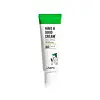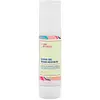What's inside
What's inside
 Key Ingredients
Key Ingredients

 Benefits
Benefits

 Concerns
Concerns

 Ingredients Side-by-side
Ingredients Side-by-side

Water
Skin ConditioningCetyl Ethylhexanoate
EmollientButylene Glycol
HumectantGlycerin
HumectantSqualane
EmollientCentella Asiatica Extract 1.05%
CleansingBacillus Ferment
Skin Conditioning1,2-Hexanediol
Skin ConditioningDicaprylyl Carbonate
EmollientCetearyl Alcohol
EmollientCetearyl Olivate
Trehalose
HumectantArachidyl Alcohol
EmollientDimethicone
EmollientSorbitan Olivate
EmulsifyingArginine
MaskingCarbomer
Emulsion StabilisingPanthenol
Skin ConditioningCaprylyl Glycol
EmollientBehenyl Alcohol
EmollientHydrogenated Lecithin
EmulsifyingArachidyl Glucoside
EmulsifyingSimmondsia Chinensis Seed Oil
EmollientMacadamia Ternifolia Seed Oil
EmollientEthylhexylglycerin
Skin ConditioningAllantoin
Skin ConditioningDimethicone/Vinyl Dimethicone Crosspolymer
Skin ConditioningSodium Hyaluronate
HumectantMentha Haplocalix Extract
MaskingSnail Secretion Filtrate 0.025%
Skin ConditioningMenthyl Lactate
MaskingDisodium EDTA
Backhousia Citriodora Leaf Oil
MaskingPhenoxyethanol
PreservativeAsiaticoside
AntioxidantMadecassic Acid
Skin ConditioningAsiatic Acid
Skin ConditioningBeta-Glucan
Skin ConditioningCitral
PerfumingWater, Cetyl Ethylhexanoate, Butylene Glycol, Glycerin, Squalane, Centella Asiatica Extract 1.05%, Bacillus Ferment, 1,2-Hexanediol, Dicaprylyl Carbonate, Cetearyl Alcohol, Cetearyl Olivate, Trehalose, Arachidyl Alcohol, Dimethicone, Sorbitan Olivate, Arginine, Carbomer, Panthenol, Caprylyl Glycol, Behenyl Alcohol, Hydrogenated Lecithin, Arachidyl Glucoside, Simmondsia Chinensis Seed Oil, Macadamia Ternifolia Seed Oil, Ethylhexylglycerin, Allantoin, Dimethicone/Vinyl Dimethicone Crosspolymer, Sodium Hyaluronate, Mentha Haplocalix Extract, Snail Secretion Filtrate 0.025%, Menthyl Lactate, Disodium EDTA, Backhousia Citriodora Leaf Oil, Phenoxyethanol, Asiaticoside, Madecassic Acid, Asiatic Acid, Beta-Glucan, Citral
Water
Skin ConditioningPropanediol
SolventNeopentyl Glycol Diheptanoate
EmollientButyrospermum Parkii Butter
Skin ConditioningCetearyl Alcohol
Emollient1,2-Hexanediol
Skin ConditioningCetearyl Olivate
Macadamia Ternifolia Seed Oil
EmollientGlyceryl Stearate
EmollientSorbitan Olivate
EmulsifyingCetyl Ethylhexanoate
EmollientCarbomer
Emulsion StabilisingTromethamine
BufferingButylene Glycol
HumectantTocopheryl Acetate
AntioxidantSodium Hyaluronate
HumectantEthylhexylglycerin
Skin ConditioningTrisodium Ethylenediamine Disuccinate
Camellia Sinensis Leaf
PerfumingCitric Acid
BufferingWater, Propanediol, Neopentyl Glycol Diheptanoate, Butyrospermum Parkii Butter, Cetearyl Alcohol, 1,2-Hexanediol, Cetearyl Olivate, Macadamia Ternifolia Seed Oil, Glyceryl Stearate, Sorbitan Olivate, Cetyl Ethylhexanoate, Carbomer, Tromethamine, Butylene Glycol, Tocopheryl Acetate, Sodium Hyaluronate, Ethylhexylglycerin, Trisodium Ethylenediamine Disuccinate, Camellia Sinensis Leaf, Citric Acid
Ingredients Explained
These ingredients are found in both products.
Ingredients higher up in an ingredient list are typically present in a larger amount.
1,2-Hexanediol is a synthetic liquid and another multi-functional powerhouse.
It is a:
- Humectant, drawing moisture into the skin
- Emollient, helping to soften skin
- Solvent, dispersing and stabilizing formulas
- Preservative booster, enhancing the antimicrobial activity of other preservatives
Butylene Glycol (or BG) is used within cosmetic products for a few different reasons:
Overall, Butylene Glycol is a safe and well-rounded ingredient that works well with other ingredients.
Though this ingredient works well with most skin types, some people with sensitive skin may experience a reaction such as allergic rashes, closed comedones, or itchiness.
Learn more about Butylene GlycolCarbomer is a polymer of acrylic acid. Its main role is to create a gel consistency.
A high amount of carbomer can cause pilling or balling up of products. Don't worry, most products contain 1% or less of carbomer.
Cetearyl alcohol is a mixture of two fatty alcohols: cetyl alcohol and stearyl alcohol. It is mainly used as an emulsifier. Emulsifiers help prevent the separation of oils and products. Due to its composition, it can also be used to thicken a product or help create foam.
Cetearyl alcohol is an emollient. Emollients help soothe and hydrate the skin by trapping moisture.
Studies show Cetearyl alcohol is non-toxic and non-irritating. The FDA allows products labeled "alcohol-free" to have fatty alcohols.
This ingredient is usually derived from plant oils such as palm, vegetable, or coconut oils. There is debate on whether this ingredient will cause acne.
Due to the fatty acid base, this ingredient may not be Malassezia folliculitis safe.
Learn more about Cetearyl AlcoholCetearyl Olivate is an emulsifier and texture enhancer. It is derived from the fatty acids of olive oil and Cetearyl alcohol, and is biodegradable.
As an emulsifier, it is used to prevent oils and waters from separating. It can also
Manufacturers use the name Olivem 1000. This ingredient has been found to preserve the natural microbiome of skin. Having a healthy microbiome helps keep our skin healthy and protects against harmful bacteria. This ingredient is grouped with Sorbitan Olivate under the name Olivem 1000.
Learn more about Cetearyl OlivateCetyl Ethylhexanoate is an emollient ester. It comes from cetearyl alcohol and 2-ethylhexanoic acid.
Cetyl Ethylhexanoate is an emollient that adds a velvety feel to skin without being greasy or oily. Emollients help trap moisture into your skin, keeping your skin soft and hydrated.
Ethylhexylglycerin (we can't pronounce this either) is commonly used as a preservative and skin softener. It is derived from glyceryl.
You might see Ethylhexylglycerin often paired with other preservatives such as phenoxyethanol. Ethylhexylglycerin has been found to increase the effectiveness of these other preservatives.
Macadamia Ternifolia Seed Oil is the fixed oil obtained from Macadamia nut.
Macadamia seed oil is rich in fatty acids, including oleic acid (45-75%), palmitoleic acid (7-33%), and palmitic acid (6-12%). They also contain various B vitamins, iron, and magnesium.
Palmitoleic acid has been shown to help soothe inflammation and promote wound healing. It is also naturally found in the fat of our skin.
Macadamia seed oil may not be malassezia folliculitis, or fungal-acne, safe.
Learn more about Macadamia Ternifolia Seed OilSodium Hyaluronate is hyaluronic acid's salt form. It is commonly derived from the sodium salt of hyaluronic acid.
Like hyaluronic acid, it is great at holding water and acts as a humectant. This makes it a great skin hydrating ingredient.
Sodium Hyaluronate is naturally occurring in our bodies and is mostly found in eye fluid and joints.
These are some other common types of Hyaluronic Acid:
Learn more about Sodium HyaluronateSorbitan Olivate is created from the fatty acids in olive oil and sorbitol.
This ingredient is an oil in water emulsifier. It helps stabilize a product by preventing oils and waters from separating. Sorbitan Olivate also helps hydrate the skin.
Manufacturers sell sorbitan olivate under the name OliveM 1000. OliveM 1000 a multifunctional ingredient. It is self-emulsifying. According to a manufacturer, OliveM 1000 does not disrupt natural skin biome.
Due to its olive oil base, this ingredient may not be fungal-acne safe.
Learn more about Sorbitan OlivateWater. It's the most common cosmetic ingredient of all. You'll usually see it at the top of ingredient lists, meaning that it makes up the largest part of the product.
So why is it so popular? Water most often acts as a solvent - this means that it helps dissolve other ingredients into the formulation.
You'll also recognize water as that liquid we all need to stay alive. If you see this, drink a glass of water. Stay hydrated!
Learn more about Water